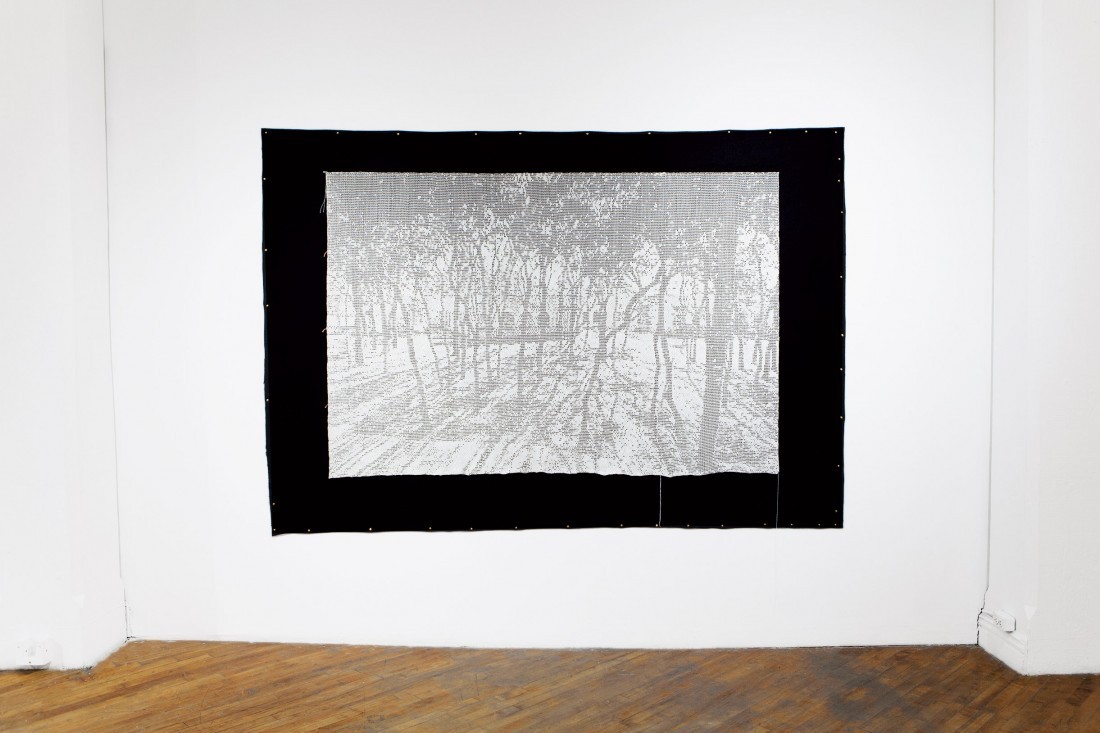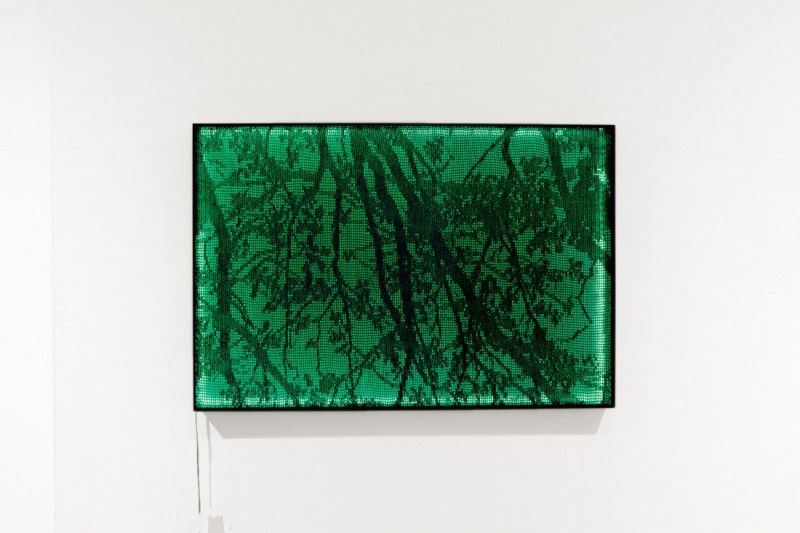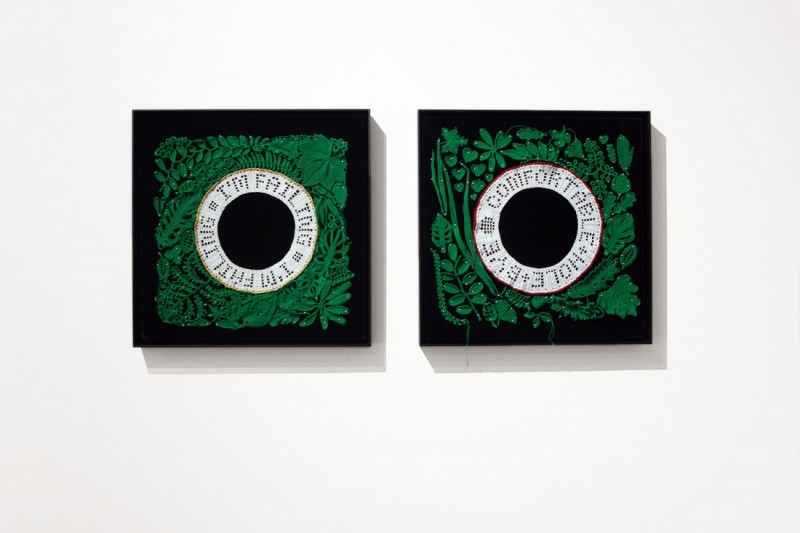Steven Leyden Cochrane
As I cannot write I put this down simply and freely as I might speak to a person to whose intimacy and tenderness I can fully intrust myself and who I know will bear with all my weaknesses. Elizabeth Parker’s embroidered sampler (sample), after 1830. (Reconstructed and down-sampled by Steven Leyden Cochrane, 2015.)
“Shining Tapestry,” by Steven Leyden Cochrane, is an exhibition of works made over an 11-year period which includes large-scale crocheted lace “tapestries,” digitally altered images, and mixed media. It is more than just a collection of individual works; it is a window into a genealogy. The beauty of what is assembled reveals a multivalent layering of themes and associations—not merely surface resemblances, but echoes and whispers of ghost-like impressions. The works critically and poetically investigate inconsistencies of subjective experience, loss and the inefficacies of language.

Steven Leyden Cochrane, Melech House, where mom died , 2017–18, crocheted cotton thread (filet crochet), 84 x 56 inches. Photos: Karen Asher. Images courtesy Ace Art Inc., Winnipeg.
Leyden Cochrane’s idiosyncratic language hinges on the medium of crochet. Traditionally associated with domestic space, the medium is adapted by the artist to present fragments of an autobiography—one plagued with suggestions of remorse and loss —which he interweaves with art historical and cultural references. Through reflection and repetition we are presented with an infinite space where the work opens outwardly in a variety of ways. His is not so much an autobiography as it is a fiction, or shares its aim with fiction. As Maurice Blanchot suggests, the “space” of fiction attempts “not to show the invisible, but to show the extent to which the invisibility of the visible is invisible.”
“Shining Tapestry” is named after the tapetum lucidum, in Latin, the iridescent and reflective coating in a cat’s eye. The artist’s cat, or “Someone to Watch over Me,” presents the first collision with a subjective other. Every animal inhabits a unique island of senses that German biologist Jakob von Uexküll termed the umwelt. As humans, our umwelt is blind to the vision this coating affords. Just as we do not recognize the range of colour that several insects see, there are limits to our perceptual reality. This exhibition is bookended with a parasensitivity to some of the micro vibrations of the animal world. We are presented with a shifting fabric of phenomenal fields, one that questions the very basis of consciousness itself.

Seneca Lake dusk (Blue screen, blackout) , 2016–17, crocheted cotton thread (filet crochet), LED light box, 43 x 29 inches.
Leyden Cochrane’s large-scale crocheted works conjure a sense of separation, of solitude. How many hours were spent in relative isolation, mentally mapping a course or counting hooks and chains? How many days turned into weeks, or even years, as the work progressed gradually over time? To crochet, one is required to loop back into an existing structure; it becomes a recursive process. Famine Stela, 2016, is a tapestry constructed as a type of bi-directional text known as “Boustrophedon.” Boustrophedon (mostly employed in ancient manuscripts around the 6th century BC) is a script that runs from left to right and right to left. The meandering quality of the form echoes not only the looping structure of the medium itself, but the improvised text. The artist weaves together two events: his mother’s death (on the night of a flash flood), in a string of disconnected phrases, with an alcoholic blackout. The stela referred to in the title is an inscribed stone slab erected as a monument for funerary purposes or to commemorate battle. Famine Stela creates a new kind of marker, one that decentres the cultural constructions we typically erect. Here, a new monument, a ‘soft marker,’ is made—not out of stone, but out of lace. It creates a monument that is more analogous with everyday experience.
Another of Leyden Cochrane’s exquisite tapestries, Melech House, where mom died, was produced over a two-year period. The tapestry portrays the setting where the artist’s mother spent her final hours. Taken from a Google image, the elongated shadows of the site merge with trees to create a mirrored, ambiguous landscape. It captures the delicate undulating light and shadow play of the trees through spaces solid and void. The site, as signifier, holds an association of suffering and upheaval on the part of its author, but as a viewer we engage with the elements of distortion. A missed stitch—or the sag of the material—holds a particular resonance. There are many, if not infinite, shapes that grief can take, and our engagement with it changes over time. In memory, we construct and reconstruct to ward off feelings of apprehension and loss; fragments are erased and re-emerge like the ripping and reworking of a hand-done piece. The activity is slow and meditative—it evolves at its own pace. To crochet also requires an active receptivity to lightness, to touch. There is a steady demand of tension from finger to thread, one that is felt—as if unconsciously—through a bodily connection to the medium. Leyden Cochrane’s soft monuments speak to the ever-shifting rhythm between the living and the departed leaving, and to the inevitable process of letting go, on which we embark.

Collar, wreath, sclera, cenote (Mom) and Collar, wreath, sclera, cenote (Koko) , 2018, unfinished, crocheted cotton thread (filet and Irish crochet), 20 x 20 inches.
With the “Black Hours” series, we are presented again with a treed landscape, but here the darkest areas of the image appear light, like a photographic negative. The works are mounted on a box with warm orange/red light. Seneca Lake dusk, 2016–17, constructed in a similar process, is mounted onto a blue-toned box. Whatever significance Seneca Lake holds for the artist himself, there is a story of mysterious, loud, exploding sounds that emanated from the New York lake. Settlers of the area called the noise the “Seneca Guns” or “Lake Drums,” this type of phenomenon being known as a “skyquake.” Seneca Lake dusk frames the image of the trees as if you were looking upward towards the sky at dusk, when the day loses its light. Leyden Cochrane further transforms the “Black Hours” and “Seneca Lake” images through animation, causing them to enlarge and dissolve generatively. Like micro-organisms growing or dividing in a particular environment, the images reduce and expand until they no longer communicate as images.
“Shining Tapestry” is blanketed with an array of allusions and repetitions. We move through fluidly, looping, collecting associations and recollecting along the way: the image of a cat’s eyes reflecting light resurfaces as two pennies on a black cloth, or the fixed and dilated pupils Joan Didion references in A Year of Magical Thinking. Pupils expand at the moment of death when they no longer respond to light stimuli. Collar, wreath, sclera, cenote (Mom), 2018, and Collar, wreath, sclera, cenote (Koko), 2018, two circular crocheted pieces, mark the apex of the exhibit and are installed close to Untitled (Someone to watch over me), 2013. In both, individual leaf motifs surround a ring of white cotton. The works are mounted onto black cloth that further accentuates the image of a dilated pupil—as void. Standing in front of this work is like staring into a cenote or into a set of eyes. The first reads, “I’m failing” (the words of his dying mother), and the second, “comfortable hole bye.” This is the response Koko the gorilla gave when asked what happens to gorillas when they die. She said, “A comfortable hole.” And gave a kiss goodbye.
“Shining Tapestry” was exhibited at Aceart, Winnipeg, from September 7 to October 5, 2018.
Elyssa Stelman lives and works in Winnipeg.

